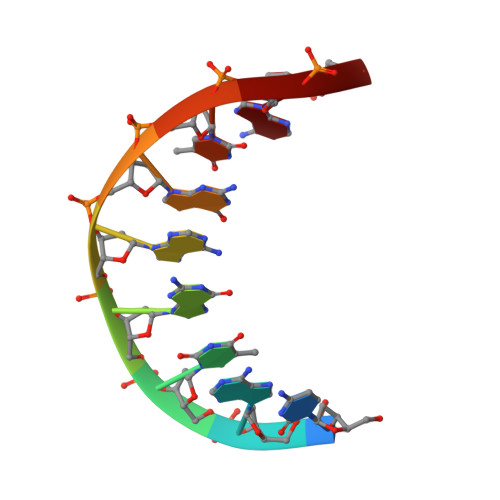7,8-Dihydro-8-oxo-1,N6-ethenoadenine: an exclusively Hoogsteen-paired thymine mimic in DNA that induces A→T transversions in Escherichia coli.
Aralov, A.V., Gubina, N., Cabrero, C., Tsvetkov, V.B., Turaev, A.V., Fedeles, B.I., Croy, R.G., Isaakova, E.A., Melnik, D., Dukova, S., Ryazantsev, D.Y., Khrulev, A.A., Varizhuk, A.M., Gonzalez, C., Zatsepin, T.S., Essigmann, J.M.(2022) Nucleic Acids Res 50: 3056-3069
- PubMed: 35234900
- DOI: https://doi.org/10.1093/nar/gkac148
- Primary Citation of Related Structures:
7NBP - PubMed Abstract:
This work investigated the structural and biological properties of DNA containing 7,8-dihydro-8-oxo-1,N6-ethenoadenine (oxo-ϵA), a non-natural synthetic base that combines structural features of two naturally occurring DNA lesions (7,8-dihydro-8-oxoadenine and 1,N6-ethenoadenine). UV-, CD-, NMR spectroscopies and molecular modeling of DNA duplexes revealed that oxo-ϵA adopts the non-canonical syn conformation (χ = 65º) and fits very well among surrounding residues without inducing major distortions in local helical architecture. The adduct remarkably mimics the natural base thymine. When considered as an adenine-derived DNA lesion, oxo-ϵA was >99% mutagenic in living cells, causing predominantly A→T transversion mutations in Escherichia coli. The adduct in a single-stranded vector was not repaired by base excision repair enzymes (MutM and MutY glycosylases) or the AlkB dioxygenase and did not detectably affect the efficacy of DNA replication in vivo. When the biological and structural data are viewed together, it is likely that the nearly exclusive syn conformation and thymine mimicry of oxo-ϵA defines the selectivity of base pairing in vitro and in vivo, resulting in lesion pairing with A during replication. The base pairing properties of oxo-ϵA, its strong fluorescence and its invisibility to enzymatic repair systems in vivo are features that are sought in novel DNA-based probes and modulators of gene expression.
Organizational Affiliation:
Shemyakin-Ovchinnikov Institute of Bioorganic Chemistry RAS, Moscow 117997, Russia.















